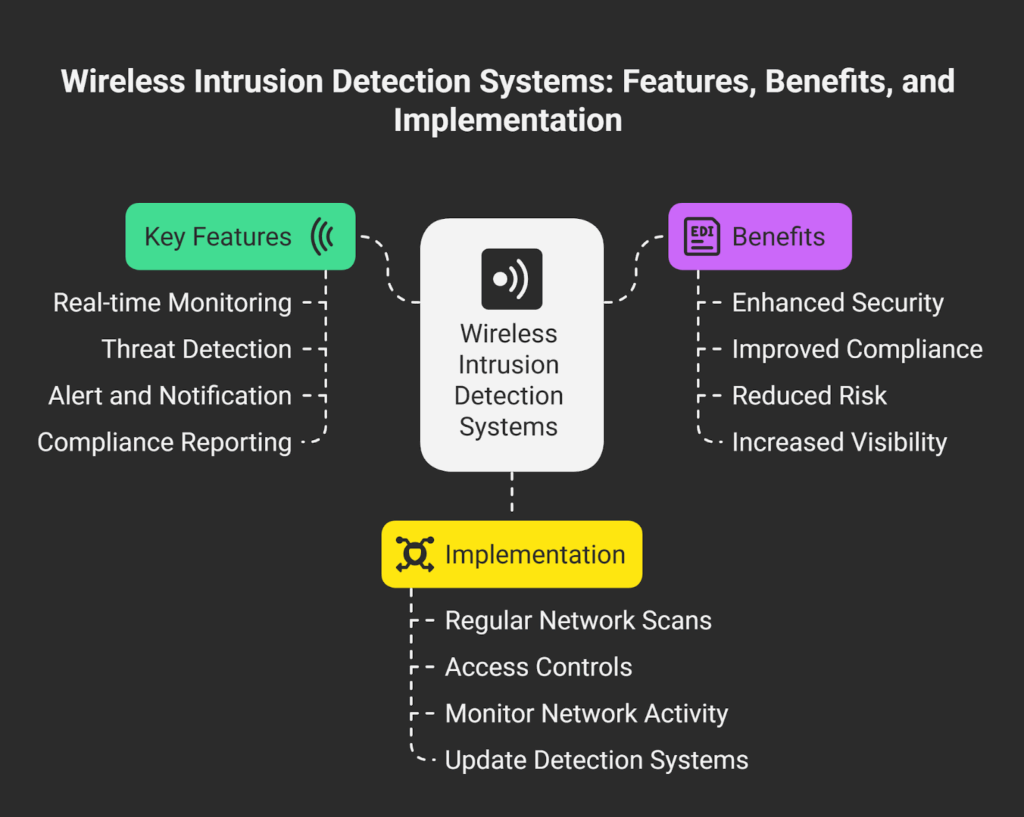Table of Contents
Importance of Wireless Intrusion Detection Systems
Wireless technology has become integral to the operation of modern enterprises. From mobile devices and laptops connecting through Wi-Fi to the growing ecosystem of Bluetooth peripherals and IoT devices, wireless connectivity drives business productivity and innovation. However, wireless communications have inherent exposures in a way that wired networks do not. Signals travel through the air, where unauthorized actors can intercept or manipulate them, presenting significant security risks. To address these vulnerabilities, modern Wireless IDS solutions have emerged as a critical layer of enterprise defense, extending protection across today’s diverse wireless environments.
Modern enterprises today do not depend solely on Wi-Fi connectivity. The adoption of Bluetooth and Bluetooth Low Energy (BLE) devices, such as smart sensors, wearables, and proximity beacons, cellular connections for mobile workforce and remote sites, and a wide variety of IoT devices using multiple wireless protocols has created complex environments that require comprehensive monitoring. Legacy systems that tracked only Wi-Fi traffic are insufficient for protecting the current multi-protocol wireless landscape.
Wireless Intrusion Detection Systems (WIDS) provide continuous monitoring across all these protocols. WIDS platforms detect unauthorized access points, rogue devices, and malicious wireless activity in real time. By offering visibility into Wi-Fi, Bluetooth, BLE, Cellular, and IoT signals, WIDS solutions enable security teams to detect and respond to threats before they cause damage or compromise sensitive data. Deploying a modern WIDS has become a mandatory component for enterprises aiming to safeguard their wireless infrastructure, comply with regulatory standards, and maintain operational resilience.
What is Wireless IDS?
A Wireless IDS is a security platform designed to monitor wireless communications and detect unauthorized devices or wireless-based attacks. Unlike traditional intrusion detection systems that focus on wired networks, WIDS extends protection to the wireless spectrum, tracking traffic and signals across multiple wireless protocols.
A WIDS continuously scans and analyzes radio frequency (RF) signals in the enterprise environment. It monitors transmissions from Wi-Fi access points, Bluetooth and BLE devices, cellular connections, and IoT sensors. The system applies multiple detection techniques, including signature-based patterns, anomaly detection, and behavioral analytics, to identify rogue devices, suspicious activity, and known attack signatures.
When it identifies a potential threat, the WIDS platforms alert security analysts and incident responders. Leading solutions, such as those Bastille Networks has pioneered, also provide the physical locations of detected devices, enabling fast and precise identification of the threat’s whereabouts within a facility. This physical location awareness is a vital element in mitigating risks that wireless intrusions pose.
Key Features of Wireless IDS
Real-Time Multi-Protocol Monitoring
The system continuously scans the wireless spectrum, covering Wi-Fi, Bluetooth, BLE, Cellular, and IoT for broad visibility. This wide-ranging detection gives security teams visibility across communication channels that traditional tools often overlook.
Multiple Detection Techniques
- Signature-Based Detection: Identifies attacks and rogue devices by matching known signatures stored in threat databases.
- Anomaly-Based Detection: Establishes normal wireless behavior baselines and alerts on deviations that may indicate unknown or zero-day threats.
- Behavioral Analysis: Understands historical device communication patterns to flag suspicious or malicious actions that deviate from norms.
- Protocol Decoding: Interprets and analyzes wireless protocols to detect protocol-specific exploits.
Instant Alerts and Notifications
Detection of threats generates real-time alerts and notifications for security analysts and incident responders, allowing swift investigation and mitigation actions. The system can integrate alerts into SIEM platforms to correlate wireless data with other security event sources.
Precise Physical Device Localization
Using various techniques, Modern Wireless IDS solutions pinpoint the physical locations of rogue or suspicious devices. Physical device tracking enables targeted response and effective mitigation inside complex facilities.
Compliance Reporting and Auditable Logs
Wireless IDS generates thorough reports detailing wireless usage, detected incidents, and response actions. These reports support compliance requirements under regulations such as HIPAA, PCI-DSS, GDPR, and NIST by providing transparent, auditable records.

Benefits of Implementing Wireless IDS
| Benefit | Description |
| Enhanced Security | Detect suspicious wireless communications and devices early to reduce data breach risks. |
| Improved Compliance | Establish continuous monitoring and thorough reporting to meet industry and governmental standards. |
| Reduced Risk | Minimize attack windows and potential damage with rapid threat detection and alerts. |
| Increased Visibility | Gain detailed insights into network access and traffic across all wireless protocols. |
Best Practices for Wireless IDS Implementation
Conduct Regular Wireless Network Scans
Maintain a current inventory of all wireless devices and access points by performing frequent or continuous scans. This inventory helps locate new or unauthorized devices before they pose a threat.
Enforce Strong Access Controls
Implement robust network access policies, including MAC address filtering, WPA3 encryption, mutual authentication, and role-based device permissions on all wireless protocols.
Enable Continuous Real-Time Wireless Monitoring
Operate Wireless IDS solutions continuously to enable immediate detection of abnormal behaviors and support rapid incident response.
Keep Systems and Signatures Updated
Regularly update Wireless IDS software and signature databases to keep pace with developing attack vectors, new devices, and protocols.
Wireless IDS Deployment Models
On-Premises Deployment
On-premises WIDS gives organizations control over hardware, software, and sensitive security data. This model is best for enterprises with strict compliance requirements, but it carries higher maintenance costs.
Cloud-Managed Deployment
In a cloud-managed model, on-premises sensors capture wireless activity while the organization coordinates analytics and management through a secure cloud platform. This deployment model reduces local infrastructure demands, enables centralized visibility across sites, and supports scalable deployments while maintaining detection accuracy.
Advanced Threat Detection
Wireless IDS platforms identify sophisticated and evolving threats, including:
- Unauthorized Devices: Detection of access points and wireless peripherals attempting to infiltrate the network or disrupt legitimate communications.
- Spoofed or Compromised Devices: Identification of endpoints masquerading as trusted devices or injecting malicious traffic.
- IoT Exploits: Recognition of vulnerable IoT devices transmitting unauthorized signals or leaking data.
- RF Manipulation Attacks: Detection of jamming, spoofing, or other signal interference aimed at disrupting communications.
- Peripheral and Bluetooth-Based Threats: Discovery of malicious or covert devices such as compromised Bluetooth headsets, wireless video transmitters, or USB Ninja Cables..
By applying layered detection across multiple protocols, Wireless IDS helps organizations address threats that traditional Wi-Fi–only monitoring systems miss.
Incident Response Planning
An effective incident response plan for Wireless IDS entails:
- Containment: Isolate affected devices and control their RF transmissions to prevent expansion of the threat.
- Eradication: Remove or remediate malicious hardware or software components.
- Recovery: Restore standard wireless communication securely.
- Post-Incident Review: Perform a thorough analysis to identify root causes and improve future defenses.
Wireless IDS provides physical localization data that accelerates these steps by giving precise threat locations.
Integration with Other Security Solutions
Wireless IDS increases enterprise security effectiveness when integrated with other security controls. Integration provides centralized event logging, correlation, automation, data sharing, and streamlined incident handling, allowing security teams to form cohesive defense strategies.
Compliance and Standards for Wireless Network Security
Wireless IDS facilitates compliance by:
- Constantly monitoring all wireless protocols in the monitored RF spectrum for unauthorized access and anomalous activity.
- Producing detailed, auditable logs that demonstrate adherence to regulatory frameworks like HIPAA, PCI-DSS, GDPR, and NIST.
- Addressing security mandates that require real-time detection and reporting of wireless threats.
Through these capabilities, enterprises can maintain governance and accountability over wireless infrastructures.
Wireless IDS Solution Selection Criteria
- Scalability: Must support growing numbers of devices, multiple sites, and evolving wireless protocols.
- Detection Breadth: Should detect threats across Wi-Fi, Bluetooth, BLE, Cellular, and IoT.
- Real-Time Alerts: Provide fast notification capabilities to reduce threat exposure.
- Integration: Seamlessly integrate with firewalls, IPS, SIEM solutions, and other security controls already in use.
- Device Localization: Provide physical device location data to support detailed threat response.
Choosing solutions that meet these criteria provides robust protection across the wireless attack surface.
Wireless IDS Implementation Challenges
Technical Complexity
Some WIDS offerings require specialized knowledge in RF spectrum, an extensive understanding of wireless protocols, and security policy tuning to avoid false alarms.
Cost
Investment involves hardware and software procurement, licensing, and ongoing support and staffing requirements.
Integration Complexity
Deploying Wireless IDS within existing security frameworks can be challenging and may require phased rollout and change management.
Proven Methods to Strengthen Wireless IDS
- Regularly update software and threat signatures.
- Maintain continuous monitoring to prevent gaps in coverage.
- Apply rigorous access control policies.
- Conduct periodic audits to assess system effectiveness.
- Train security personnel in Wireless IDS operations and incident response.
Wireless IDS Future Trends
Artificial Intelligence and Machine Learning
AI and ML models improve detection accuracy by analyzing complex wireless traffic patterns, reducing false positives, and enabling faster response.
Cloud-Managed Deployments
Cloud-managed models offer scalability, centralized visibility, and simplified management. This approach supports large-scale, multi-site security operations without increasing on-premises complexity.
Ecosystem Integration
Deeper integration with endpoint detection, firewalls, and SIEM platforms strengthens unified security operations and enhances threat intelligence sharing.
Key Questions About Wireless IDS and Network Security
What is Wireless IDS?
A security system that monitors wireless protocols to detect unauthorized devices and wireless-based attacks.
Why is Wireless IDS important?
It protects wireless environments from attacks that wired network security cannot see.
What are its key features?
Multi-protocol coverage, real-time alerting, device localization, and compliance support.
How can I improve the performance of wireless intrusion detection systems?
Through frequent updates, continuous monitoring, tuned alerting, and regular audits.
What deployment options are there?
On-premises or cloud-managed, depending on enterprise needs.
Why is incident response planning essential?
To enable rapid and organized containment and recovery from detected wireless threats.
Closing the Gaps in Wireless Network Protection
Wireless Intrusion Detection Systems are vital in today’s complex wireless environments. Bastille delivers broad multi-protocol coverage, precise localization, and advanced analytics, without requiring specialized knowledge in the RF spectrum or a deep understanding of wireless protocols. This capability gives security teams the visibility to identify and address wireless threats quickly, protect sensitive data, and support regulatory compliance.



